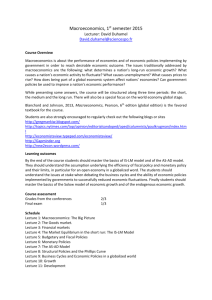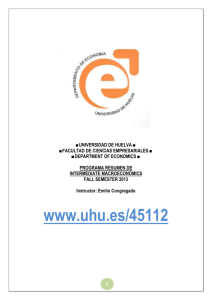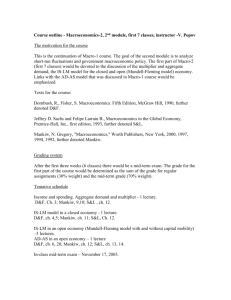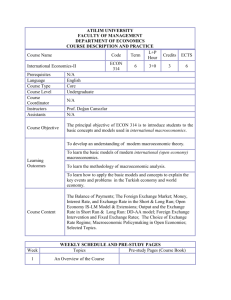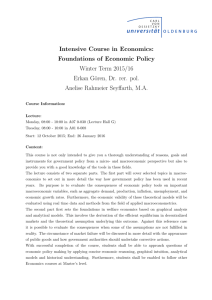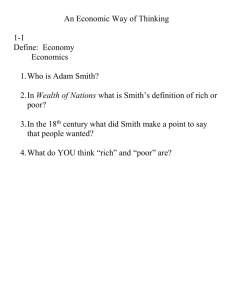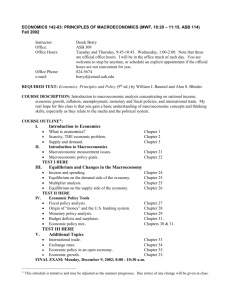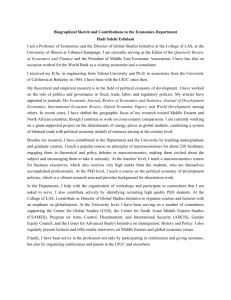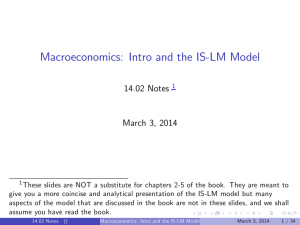ECONOMICS 304–1 INTERMEDIATE MACROECONOMIC THEORY
advertisement
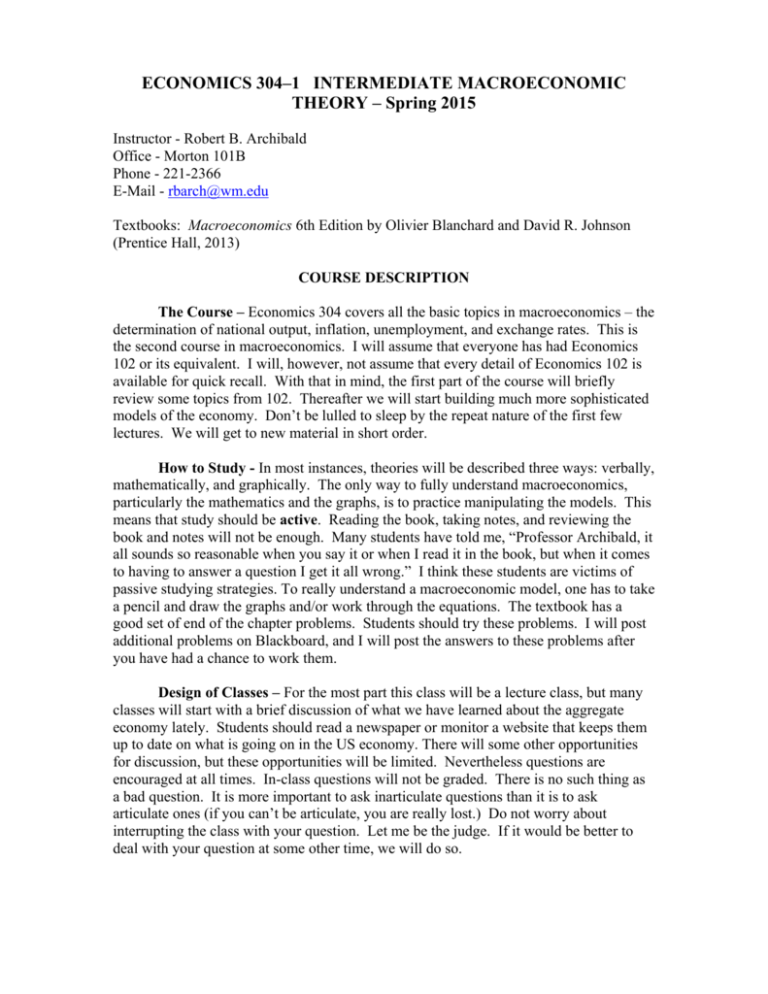
ECONOMICS 304–1 INTERMEDIATE MACROECONOMIC THEORY – Spring 2015 Instructor - Robert B. Archibald Office - Morton 101B Phone - 221-2366 E-Mail - rbarch@wm.edu Textbooks: Macroeconomics 6th Edition by Olivier Blanchard and David R. Johnson (Prentice Hall, 2013) COURSE DESCRIPTION The Course – Economics 304 covers all the basic topics in macroeconomics – the determination of national output, inflation, unemployment, and exchange rates. This is the second course in macroeconomics. I will assume that everyone has had Economics 102 or its equivalent. I will, however, not assume that every detail of Economics 102 is available for quick recall. With that in mind, the first part of the course will briefly review some topics from 102. Thereafter we will start building much more sophisticated models of the economy. Don’t be lulled to sleep by the repeat nature of the first few lectures. We will get to new material in short order. How to Study - In most instances, theories will be described three ways: verbally, mathematically, and graphically. The only way to fully understand macroeconomics, particularly the mathematics and the graphs, is to practice manipulating the models. This means that study should be active. Reading the book, taking notes, and reviewing the book and notes will not be enough. Many students have told me, “Professor Archibald, it all sounds so reasonable when you say it or when I read it in the book, but when it comes to having to answer a question I get it all wrong.” I think these students are victims of passive studying strategies. To really understand a macroeconomic model, one has to take a pencil and draw the graphs and/or work through the equations. The textbook has a good set of end of the chapter problems. Students should try these problems. I will post additional problems on Blackboard, and I will post the answers to these problems after you have had a chance to work them. Design of Classes – For the most part this class will be a lecture class, but many classes will start with a brief discussion of what we have learned about the aggregate economy lately. Students should read a newspaper or monitor a website that keeps them up to date on what is going on in the US economy. There will some other opportunities for discussion, but these opportunities will be limited. Nevertheless questions are encouraged at all times. In-class questions will not be graded. There is no such thing as a bad question. It is more important to ask inarticulate questions than it is to ask articulate ones (if you can’t be articulate, you are really lost.) Do not worry about interrupting the class with your question. Let me be the judge. If it would be better to deal with your question at some other time, we will do so. COURSE OUTLINE DATE TOPIC January 21 Introduction January 23 Economic Indicators - GDP 2 January 26 GDP and Unemployment 2 January 28 Inflation 2 January 30 Goods Market I 3 February 2 Goods Market II 3 February 4 Financial Markets I 4 February 6 Financial Markets II 4 February 9 IS-LM I 5 February 11 IS-LM II 5 February 13 5 IS-LM III READING 1 and Appendix 1 February 16 EXAM I February 18 Labor Markets I 6 February 20 Labor Markets II 6 February 23 AD-AS Model I 7 February 25 AD-AS Model II 7 February 27 Phillips Curves 8 March 2 The Crisis I First Take-Home Quiz due 9 March 4 The Crisis II 9 March 6 Growth I 10 Spring Break March 16 Growth II 11 March 18 Growth III 12 March 20 Technological Progress 13 March 23 Expectations Second Take-Home Quiz due 14 March 25 Financial Markets Again I 15 March 27 Financial Markets Again II 15 March 30 Output Markets Again 16 April 1 No Class April 3 Expectations and Policy April 6 Review for Exam II April 8 Exam II April 10 Open Economy I 18 April 13 Open Economy and Goods Market 19 April 15 Open Economy IS-LM 1 20 April 17 Open Economy IS-LM II 20 April 20 Exchange Rate Regimes I 21 April 22 Exchange Rate Regimes II 21 April 24 Policy I Third Take-Home Quiz due 22 April 27 Fiscal Policy 23 April 29 Monetary Policy 24 May 1 Review 17 May 11 Final Exam (9:00 – 12:00) Grades: Grades will be based on the two in-class exams (75 points for the first and 100 points for the second), 75 points for the three take home quizzes, and the final exam (200 points). As a result 38.9% of the grade will be based on in-class exams, 16.7% will be based on the take-home quizzes, and 44.4% will be based on the final exam.
